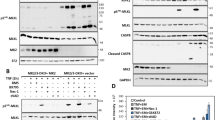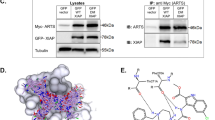Abstract
Death receptor 5 (DR5) is a receptor for tumor necrosis factor-related apoptosis-inducing ligand (TRAIL). TRAIL is a promising candidate for cancer therapeutics due to its ability to induce apoptosis selectively in cancer cells. Here, we report that histone deacetylase inhibitors (HDACIs) such as trichostatin A (TSA), sodium butyrate, and suberoylanilide hydroxamic acid (SAHA) upregulated DR5 expression in various human malignant tumor cells. An RNase protection assay demonstrated that HDACIs induced DR5 mRNA markedly but not that of other death receptor family members in Jurkat cells. HDACIs increased DR5 mRNA and protein in a dose- and time-dependent manner. We also show TSA increased DR5 promoter activity using a luciferase promoter assay. Furthermore, we demonstrated that HDACIs strongly sensitized exogenous soluble recombinant human TRAIL-induced apoptosis synergistically in Jurkat and HL-60 cells that were tolerant to TRAIL alone. The combined use of HDACIs and TRAIL in suboptimal concentrations induced Bid cleavage and activation of caspase-8, -10, -3, and -9. Human recombinant DR5/Fc chimera protein, zVAD-fmk pancaspase inhibitor, and caspase-8 and -10 inhibitors efficiently reduced apoptosis induced by cotreatment with HDACIs and TRAIL. Furthermore, TSA did not significantly induce DR5 protein and HDACIs did not enhance TRAIL-induced apoptosis in normal human peripheral blood mononuclear cells. These results suggest that this combined treatment with HDACIs and TRAIL is a promising strategy for new cancer therapeutics.
This is a preview of subscription content, access via your institution
Access options
Subscribe to this journal
Receive 50 print issues and online access
$259.00 per year
only $5.18 per issue
Buy this article
- Purchase on Springer Link
- Instant access to full article PDF
Prices may be subject to local taxes which are calculated during checkout








Similar content being viewed by others
Abbreviations
- DR5:
-
death receptor 5
- TRAIL:
-
tumor necrosis factor-related apoptosis-inducing ligand
- TNF:
-
tumor necrosis factor
- HDACIs:
-
histone deacetylase inhibitors
- TSA:
-
trichostatin A
- SAHA:
-
suberoylanilide hydroxamic acid
- GAPDH:
-
glyceraldehyde-3-phosphate dehydrogenase
References
Ashkenazi A and Dixit VM . (1998). Science, 281, 1305–1308.
Ashkenazi A and Dixit VM . (1999). Curr. Opin. Cell Biol., 11, 255–260.
Ashkenazi A, Pai RC, Fong S, Leung S, Lawrence DA, Marsters SA, Blackie C, Chang L, McMurtrey AE, Hebert A, DeForge L, Koumenis IL, Lewis D, Harris L, Bussiere J, Koeppen H, Shahrokh Z and Schwall RH . (1999). J. Clin. Invest., 104, 155–162.
Davie JR . (1998). Curr. Opin. Genet. Dev., 8, 173–178.
Gibson SB, Oyer R, Spalding AC, Anderson SM and Johnson GL . (2000). Mol. Cell. Biol., 20, 205–212.
Gong B and Almasan A . (2000). Cancer Res., 60, 5754–5760.
Griffith TS, Rauch CT, Smolak PJ, Waugh JY, Boiani N, Lynch DH, Smith CA, Goodwin RG and Kubin MZ . (1999). J. Immunol., 162, 2597–2605.
He Q, Lee DI, Rong R, Yu M, Luo X, Klein M, El-Deiry WS, Huang Y, Hussain A and Sheikh MS . (2002a). Oncogene, 21, 2623–2633.
He Q, Luo X, Huang Y and Sheikh MS . (2002b). Oncogene, 21, 6032–6040.
Hirose T, Sowa Y, Takahashi S, Saito S, Yasuda C, Shindo N, Furuichi K and Sakai T . (2003). Oncogene, 22, 7762–7773.
Hitomi T, Matsuzaki Y, Yokota T, Takaoka Y and Sakai T . (2003). FEBS Lett., 554, 347–350.
Huang L, Sowa Y, Sakai T and Pardee AB . (2000). Oncogene, 19, 5712–5719.
Huang Y, He Q, Hillman MJ, Rong R and Sheikh MS . (2001). Cancer Res., 61, 6918–6924.
Ichikawa K, Liu W, Zhao L, Wang Z, Liu D, Ohtsuka T, Zhang H, Mountz JD, Koopman WJ, Kimberly RP and Zhou T . (2001). Nat. Med., 7, 954–960.
Inoue H, Shiraki K, Ohmori S, Sakai T, Deguchi M, Yamanaka T, Okano H and Nakano T . (2002). Int. J. Mol. Med., 9, 521–525.
Jang YJ, Park KS, Chung HY and Kim HI . (2003). Cancer Lett., 194, 107–117.
Jo M, Kim TH, Seol DW, Esplen JE, Dorko K, Billiar TR and Strom SC . (2000). Nat. Med., 6, 564–567.
Keane MM, Ettenberg SA, Nau MM, Russell EK and Lipkowitz S . (1999). Cancer Res., 59, 734–741.
Kischkel FC, Lawrence DA, Tinel A, LeBlanc H, Virmani A, Schow P, Gazdar A, Blenis J, Arnott D and Ashkenazi A . (2001). J. Biol. Chem., 276, 46639–46646.
Koornstra JJ, Kleibeuker JH, van Geelen CM, Rijcken FE, Hollema H, de Vries EG and de Jong S . (2003). J. Pathol., 200, 327–335.
Kouzarides T . (1999). Curr. Opin. Genet. Dev., 9, 40–48.
Kramer OH, Gottlicher M and Heinzel T . (2001). Trends Endocrinol. Metab., 12, 294–300.
Kuang AA, Diehl GE, Zhang J and Winoto A . (2000). J. Biol. Chem., 275, 25065–25068.
LaVallee TM, Zhan XH, Johnson MS, Herbstritt CJ, Swartz G, Williams MS, Hembrough WA, Green SJ and Pribluda VS . (2003). Cancer Res., 63, 468–475.
Lawrence D, Shahrokh Z, Marsters S, Achilles K, Shih D, Mounho B, Hillan K, Totpal K, DeForge L, Schow P, Hooley J, Sherwood S, Pai R, Leung S, Khan L, Gliniak B, Bussiere J, Smith CA, Strom SS, Kelley S, Fox JA, Thomas D and Ashkenazi A . (2001). Nat. Med., 7, 383–385.
LeBlanc HN and Ashkenazi A . (2003). Cell Death Differ., 10, 66–75.
MacFarlane M, Ahmad M, Srinivasula SM, Fernandes-Alnemri T, Cohen GM and Alnemri ES . (1997). J. Biol. Chem., 272, 25417–25420.
Mariani SM, Matiba B, Armandola EA and Krammer PH . (1997). J. Cell Biol., 137, 221–229.
Marks PA, Richon VM and Rifkind RA . (2000). J. Natl. Cancer Inst., 92, 1210–1216.
Meng RD and El-Deiry WS . (2001). Exp. Cell Res., 262, 154–169.
Mitsiades N, Poulaki V, Mitsiades C and Tsokos M . (2001). Cancer Res., 61, 2704–2712.
Muhlenbeck F, Haas E, Schwenzer R, Schubert G, Grell M, Smith C, Scheurich P and Wajant H . (1998). J. Biol. Chem., 273, 33091–33098.
Nagane M, Pan G, Weddle JJ, Dixit VM, Cavenee WK and Huang HJ . (2000). Cancer Res., 60, 847–853.
Nakano K, Mizuno T, Sowa Y, Orita T, Yoshino T, Okuyama Y, Fujita T, Ohtani-Fujita N, Matsukawa Y, Tokino T, Yamagishi H, Oka T, Nomura H and Sakai T . (1997). J. Biol. Chem., 272, 22199–22206.
Neuzil J, Swettenham E and Gellert N . (2004). Biochem. Biophys. Res. Commun., 314, 186–191.
Oh SC, Nam SY, Kwon HC, Kim CM, Seo JS, Seong RH, Jang YJ, Chung YH and Chung HY . (2001). Mol. Cell, 11, 192–197.
Ohtsuka T, Buchsbaum D, Oliver P, Makhija S, Kimberly R and Zhou T . (2003). Oncogene, 22, 2034–2044.
Pan G, Ni J, Wei YF, Yu G, Gentz R and Dixit VM . (1997). Science, 277, 815–818.
Pitti RM, Marsters SA, Ruppert S, Donahue CJ, Moore A and Ashkenazi A . (1996). J. Biol. Chem., 271, 12687–12690.
Rosato RR, Almenara JA, Dai Y and Grant S . (2003). Mol. Cancer Ther., 2, 1273–1284.
Screaton GR, Mongkolsapaya J, Xu XN, Cowper AE, McMichael AJ and Bell JI . (1997). Curr. Biol., 7, 693–696.
Sheikh MS, Burns TF, Huang Y, Wu GS, Amundson S, Brooks KS, Fornace Jr AJ and El-Deiry WS . (1998). Cancer Res., 58, 1593–1598.
Sheridan JP, Marsters SA, Pitti RM, Gurney A, Skubatch M, Baldwin D, Ramakrishnan L, Gray CL, Baker K, Wood WI, Goddard AD, Godowski P and Ashkenazi A . (1997). Science, 277, 818–821.
Shigeno M, Nakao K, Ichikawa T, Suzuki K, Kawakami A, Abiru S, Miyazoe S, Nakagawa Y, Ishikawa H, Hamasaki K, Nakata K, Ishii N and Eguchi K . (2003). Oncogene, 22, 1653–1662.
Sowa Y, Orita T, Minamikawa S, Nakano K, Mizuno T, Nomura H and Sakai T . (1997). Biochem. Biophys. Res. Commun., 241, 142–150.
Strahl BD and Allis CD . (2000). Nature, 403, 41–45.
Sun SY, Yue P, Wu GS, El-Deiry WS, Shroot B, Hong WK and Lotan R . (1999). Oncogene, 18, 2357–2365.
Takimoto R and El-Deiry WS . (2000). Oncogene, 19, 1735–1743.
Tang X, Sun YJ, Half E, Kuo MT and Sinicrope F . (2002). Cancer Res., 62, 4903–4908.
Walczak H, Bouchon A, Stahl H and Krammer PH . (2000). Cancer Res., 60, 3051–3057.
Walczak H, Degli-Esposti MA, Johnson RS, Smolak PJ, Waugh JY, Boiani N, Timour MS, Gerhart MJ, Schooley KA, Smith CA, Goodwin RG and Rauch CT . (1997). EMBO J., 16, 5386–5397.
Walczak H, Miller RE, Ariail K, Gliniak B, Griffith TS, Kubin M, Chin W, Jones J, Woodward A, Le T, Smith C, Smolak P, Goodwin RG, Rauch CT, Schuh JC and Lynch DH . (1999). Nat. Med., 5, 157–163.
Wen J, Ramadevi N, Nguyen D, Perkins C, Worthington E and Bhalla K . (2000). Blood, 96, 3900–3906.
Wu GS, Burns TF, McDonald III ER, Jiang W, Meng R, Krantz ID, Kao G, Gan DD, Zhou JY, Muschel R, Hamilton SR, Spinner NB, Markowitz S, Wu G and El-Deiry WS . (1997). Nat. Genet., 17, 141–143.
Wu GS, Burns TF, McDonald III ER, Meng RD, Kao G, Muschel R, Yen T and El-Deiry WS . (1999). Oncogene, 18, 6411–6418.
Yeh WC, Pompa JL, McCurrach ME, Shu HB, Elia AJ, Shahinian A, Ng M, Wakeham A, Khoo W, Mitchell K, El-Deiry WS, Lowe SW, Goeddel DV and Mak TW . (1998). Science, 279, 1954–1958.
Yoshida M and Beppu T . (1988). Exp. Cell Res., 177, 122–131.
Yoshida T, Maeda A, Tani N and Sakai T . (2001). FEBS Lett., 507, 381–385.
Zhang XD, Gillespie SK, Borrow JM and Hersey P . (2003). Biochem. Pharmacol., 66, 1537–1545.
Acknowledgements
We thank Dr Takafumi Kimura (Department of Hygiene, Kyoto Prefectural University of Medicine) for very helpful experimental advice. This work was supported by the Japanese Ministry of Education, Culture, Sports, Science, and Technology, a grant (H11-Seikatsu-018) for Research on Environmental Health from the Ministry of Health, Labor, and Welfare of Japan, and the SRF Grant for Biomedical Research.
Author information
Authors and Affiliations
Corresponding author
Rights and permissions
About this article
Cite this article
Nakata, S., Yoshida, T., Horinaka, M. et al. Histone deacetylase inhibitors upregulate death receptor 5/TRAIL-R2 and sensitize apoptosis induced by TRAIL/APO2-L in human malignant tumor cells. Oncogene 23, 6261–6271 (2004). https://doi.org/10.1038/sj.onc.1207830
Received:
Revised:
Accepted:
Published:
Issue Date:
DOI: https://doi.org/10.1038/sj.onc.1207830
Keywords
This article is cited by
-
Venetoclax efficacy on acute myeloid leukemia is enhanced by the combination with butyrate
Scientific Reports (2024)
-
Generation of TRAIL-resistant cell line models reveals distinct adaptive mechanisms for acquired resistance and re-sensitization
Oncogene (2021)
-
89Zr and 177Lu labeling of anti-DR5 monoclonal antibody for colorectal cancer targeting PET-imaging and radiotherapy
Journal of Radioanalytical and Nuclear Chemistry (2021)
-
Mechanisms underlying CD19-positive ALL relapse after anti-CD19 CAR T cell therapy and associated strategies
Biomarker Research (2020)
-
HDAC inhibitors overcome immunotherapy resistance in B-cell lymphoma
Protein & Cell (2020)



